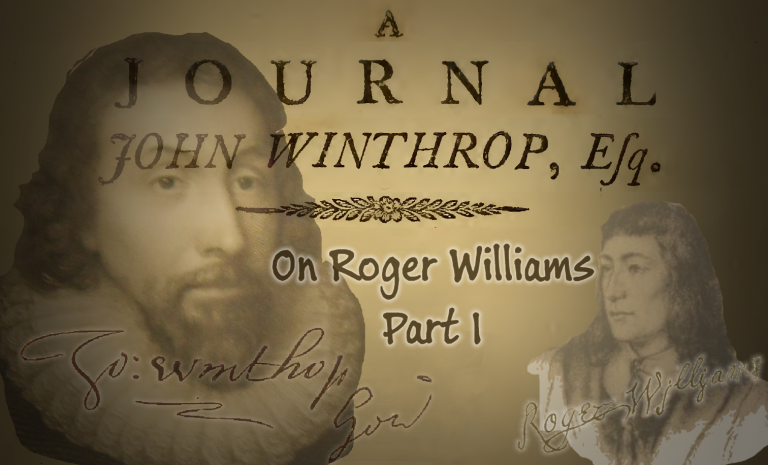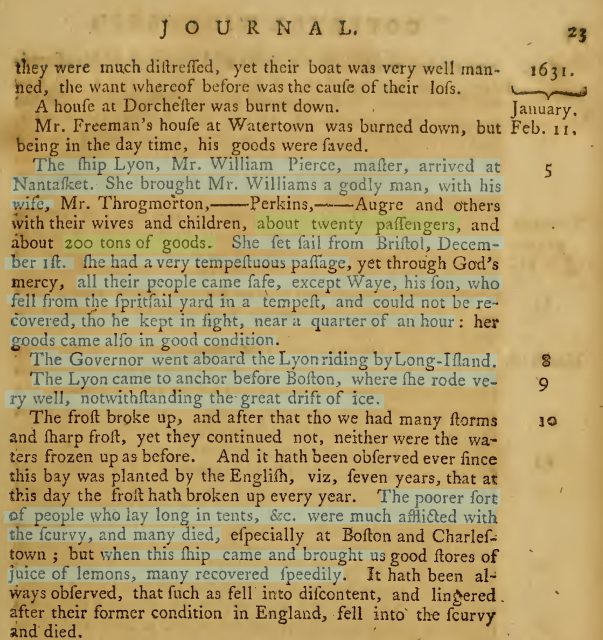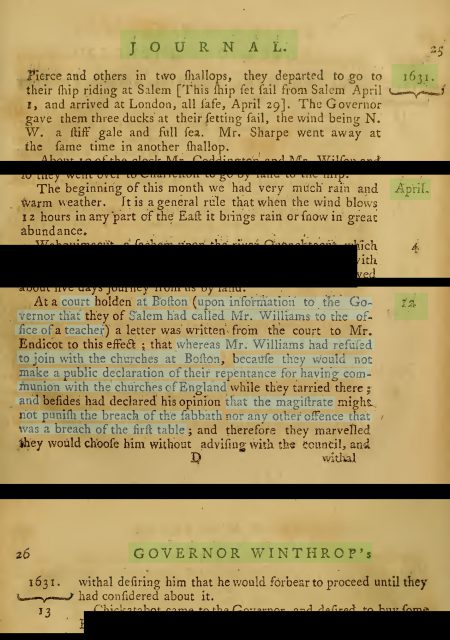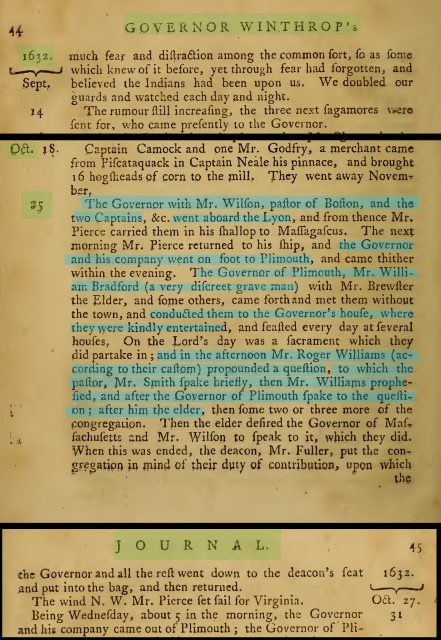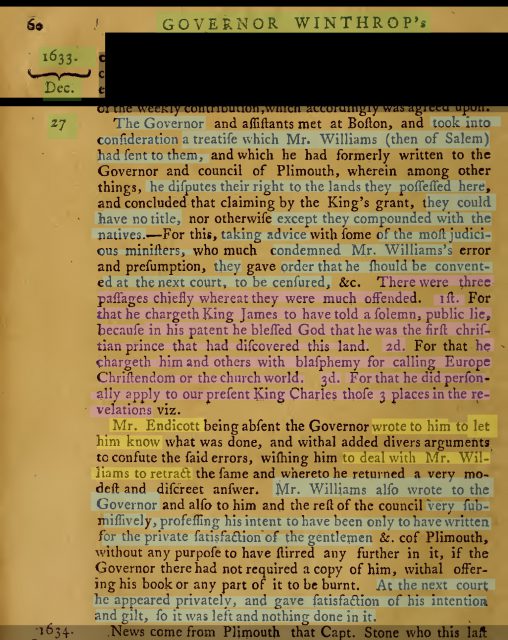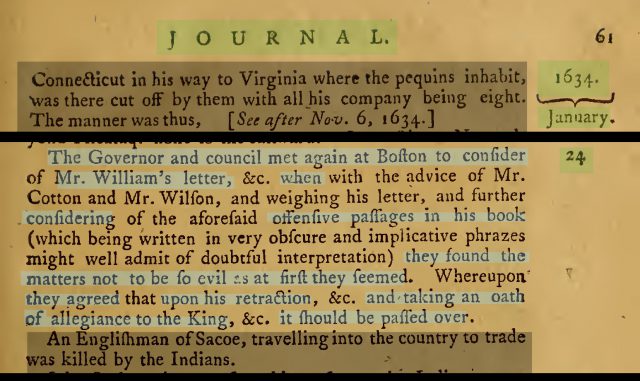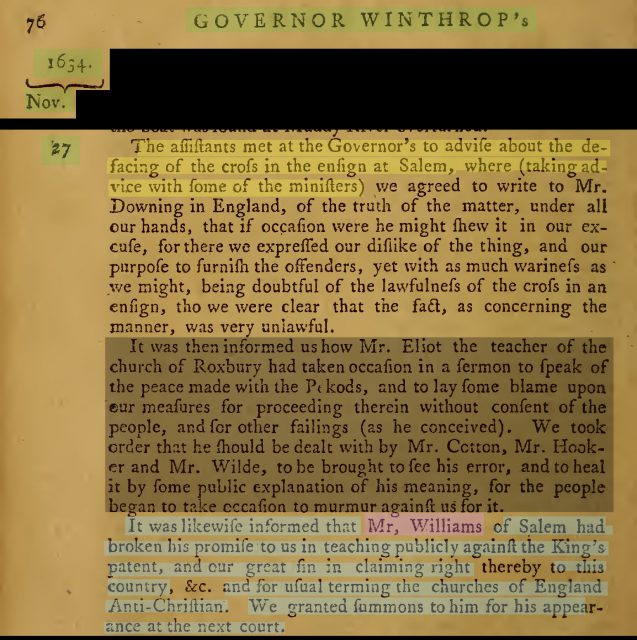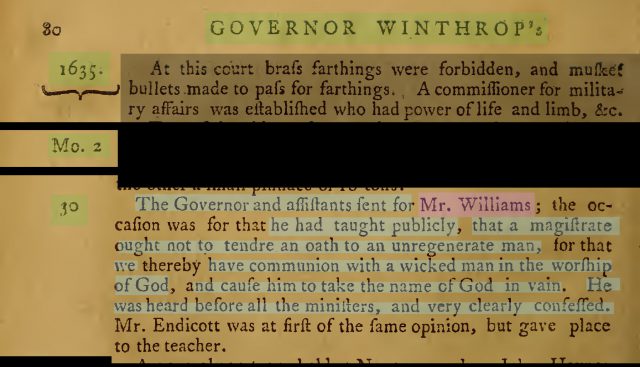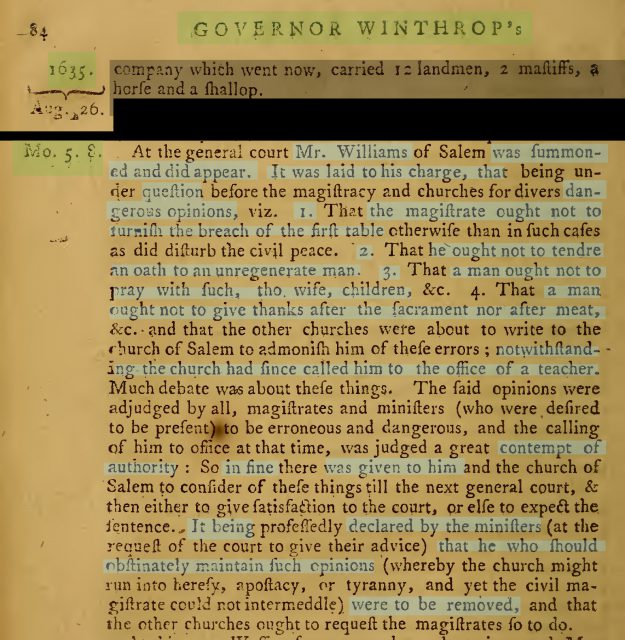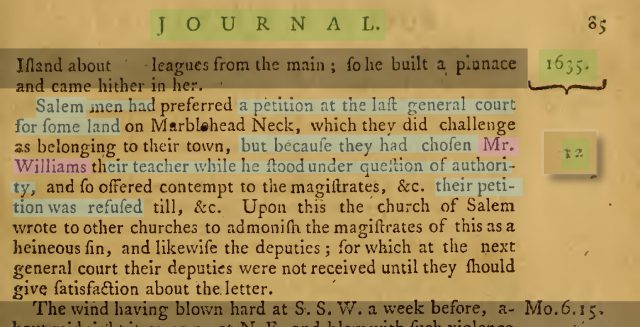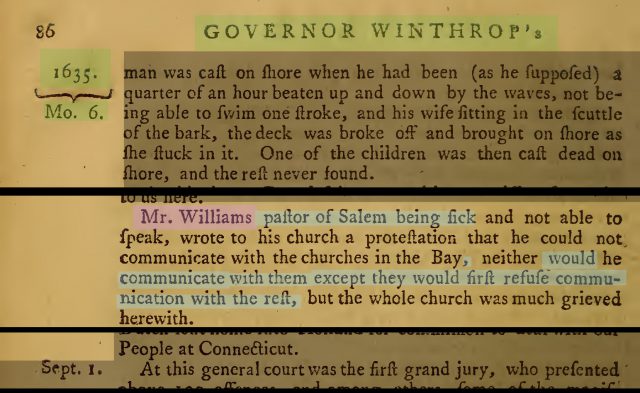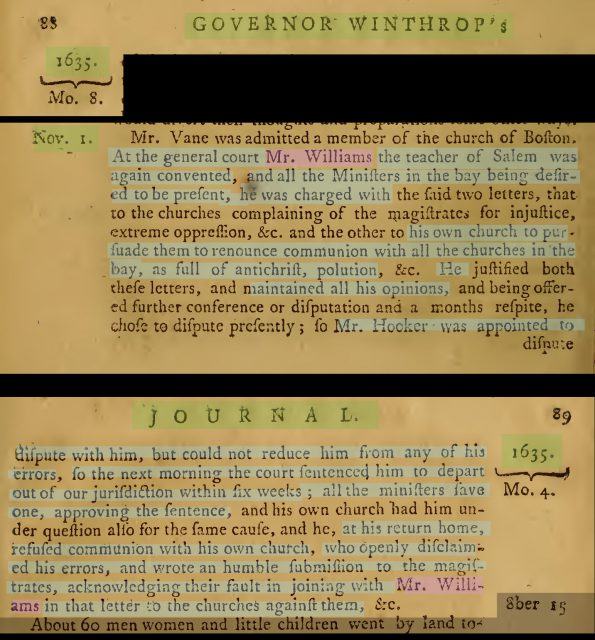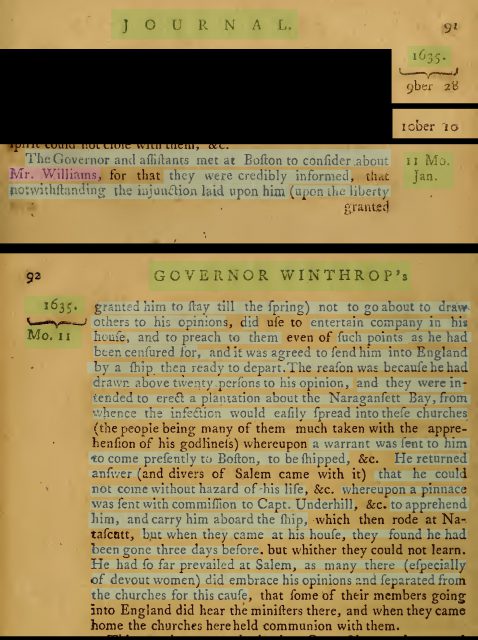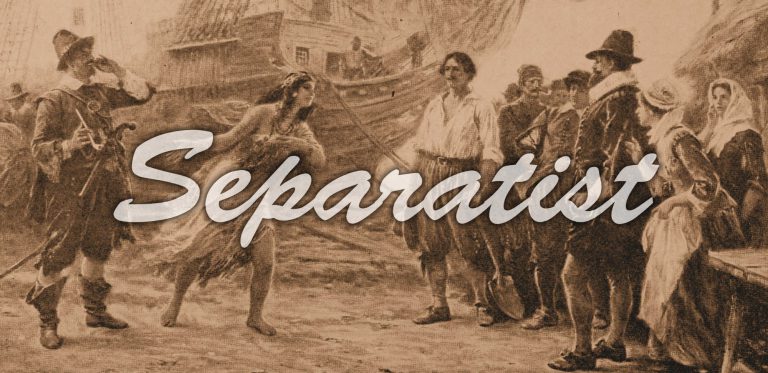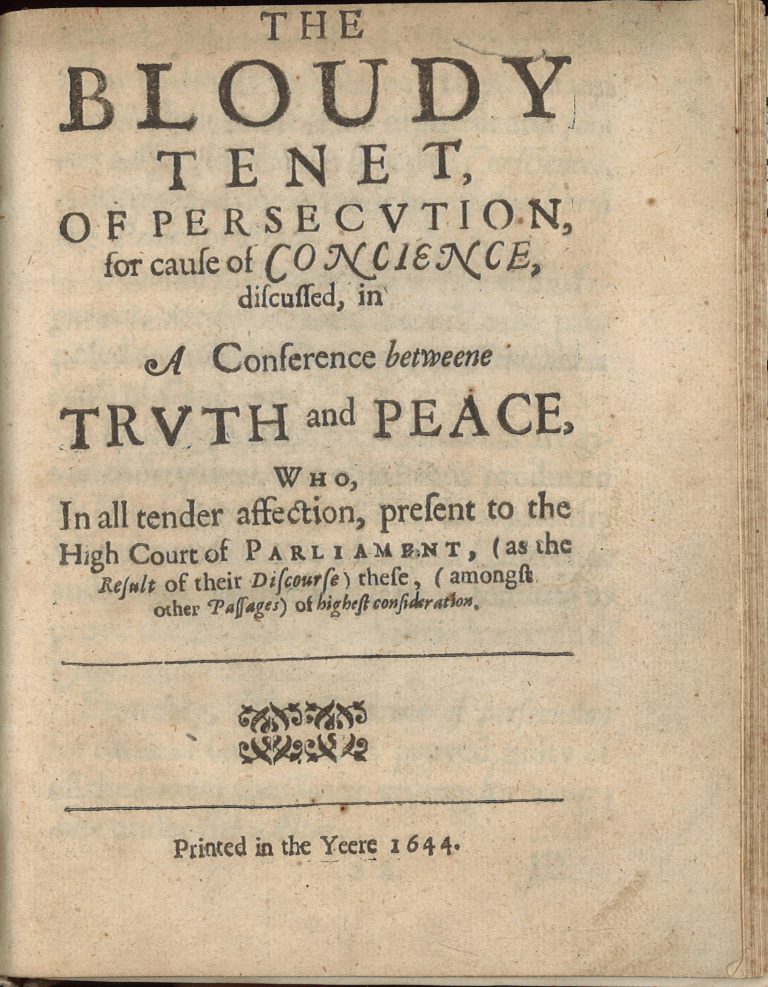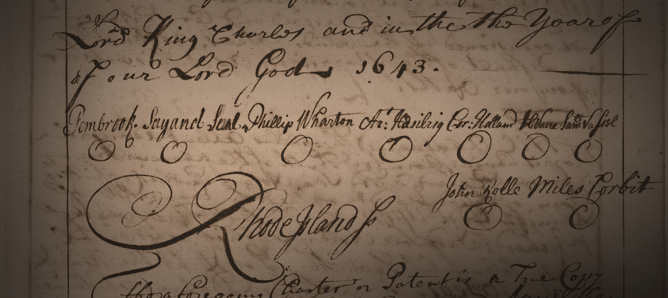John Winthrop Journal 1630-Jan 1636; Analysis of Roger Williams
- Part 1: 1630-Jan 1636 — with quotes and clips from journal published in 1790.
- Part 2: 1636-1644 — with quotes and clips from journal published in 1790.
- Part 3: 1645-1649 — with quotes from journal published in 1908.
RESEARCH PAPER: John Winthrop was the first governor of the Massachusetts Bay Colony and governor for 12 of its first 20 years. Luckily for all of us, he kept a journal for the last 19 years of his life — from March 29, 1630 through January 11, 1649. He died in Boston on March 26, 1649, nearly three months after his last journal entry. In this article, we’ll explore Roger Williams from the eyes of John Winthrop’s journal. To be clear, 40+ letters between John Winthrop and Roger Williams have also survived the test of time, but this article is an analysis of the entries related to Roger Williams in this journal.
John Adam’s Copy of Journal, Published 1790
I’m using two editions of his journal. The first was published in 1790, which was the first time the Winthrop journal was published and is considered a faithful copy. It covers up to 1644 and the clips below through 1636 are from that edition.
The specific copy I am using came from the personal library of John Adams — a founding father and 2nd President of the United States. In this article, you will get to read the same words one of our founding fathers read about Roger Williams. This is the same copy John Adams laid his eyes upon. In part 2 of this article, I will use clips from this edition through 1644.
In part 3, I use the edition published in 1908 which includes additional journal entries from 1645-1649.
First Page of the Original Journal:
The following page is the first page of John Winthrop’s journal in his own hand:
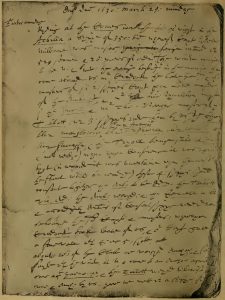
John Winthrop, a moderate?
John Winthrop (1587-1649) was the governor of the Massachusetts Bay Colony for 12 of its first 20 years, including in January 1635 when the colony banished Roger Williams. In fact, you’ll see later in this article that John Winthrop warned Roger Williams that Capt. Underhill was on his way to arrest Roger Williams and send him back to England for trial.
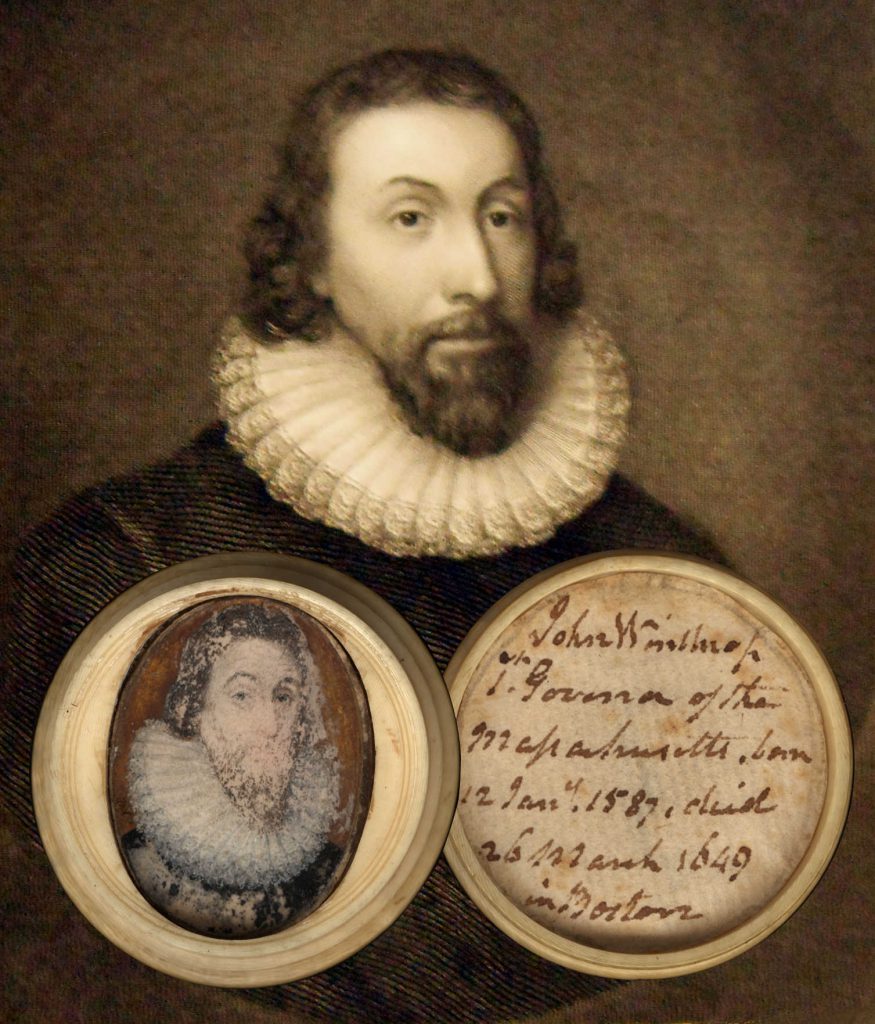
If you apply the liberal, moderate, and conservative labels from today, you would label Roger Williams a liberal, John Winthrop a right-leaning moderate who favored aristocratic authority and old-world hierarchical social divisions. You would label the colony as very conservative. Roger and John respected each other’s opinions on all matters and communicated and engaged in civil debate frequently, including in letters until John’s death in 1649. Roger continued communication with his son John Winthrop Jr. (1606-1676). Arguably, one could say that the struggle in America between liberal-types and conservative-types started back in the early days of the colonies.
A Note About Dates
The heading dates are based on the old Julian calendar in use by John Winthrop. They are for reference and usually refer to the date of the event, but not always. As with many journals, an entry might talk about the day’s events or past events. In the Winthrop journal, he took great care to use an event date. In fact, there are some entries out of order for this reason.
The days of the week are the same as they are today. Monday’s were the first day of the week, so when Winthrop writes “the third day of the week”, he’s referring to Wednesday.
In the Winthrop diary, February is the 12th month, March is month 1. When you see “Mo. 4.” in this journal it means the 4th month of the year. So the 4th month is June (Mar, Apr, May, Jun). When you see “Mo. 8 6” or “8. 6.” that means the 6th day of the 8th month.
February 5, 1630/1: Roger Williams and wife Mary arrive on the ship Lyon
English Double Date: 5 Feb 1630/1 is 5 Feb 1631 (month 2); and 5 Feb 1630 (month 12).
Julian to Gregorian Conversion: John’s Julian calendar of Saturday 5 Feb 1630/1 = Saturday 15 Feb 1631 Gregorian, our calendar.
Date Analysis: The notation “Feb. 11.” documents that February is their 11 month of the year. The traditional date used for the arrival of Roger Williams is Saturday, February 5, 1631. We say, “He arrived in the second month of 1631 on February 5th.” In John Winthrop’s time, they would have said, “He arrived on the 12th month of 1630 on February 5th.”
Governor: John Winthrop (age 43); Deputy Governor: Thomas Dudley (age 55)
Characters: Roger Williams (age 27) and wife Mary (age 22)
Roger Williams left England for New England in 1630. This was about 5 years after King Charles I came to power. At the time, there was a general distrust of Charles’ religious and political policies which eventually led to a civil war starting about 1642 and ending with Charles’ beheading in 1649.
Roger Williams left England because he felt they were on the wrong path. Specifically, he took great offense at religious persecution as well as persecution for thinking or believing something. For sure he felt individuals had a God-given right to believe whatever they believed. Through valid arguments, you can attempt to change their beliefs, but ultimately it is their choice. It is likely that if Roger Williams stayed in England, he would have been persecuted.
Roger and his wife Mary travelled on a ship called Lyon. They travelled along with about 20 passengers from Bristol, England and landed at Salem, Massachusetts. The ship set sail from Bristol on December 1, 1630, and after 65 days at sea arrived on February 5, 1630/1. Only one died during the journey. The son of Mr. Waye fell overboard during a storm and although he struggled for about 15 minutes, they could not rescue him before he went under. The ship was also carrying about 200 tons of goods. When the Lyon arrived, it had to navigate around and through a great drift of ice. Many of the poor lived in tents along the shore and had scurvy and many died. The Lyon was carrying lemon juice which helped many of the poor recover quickly.
Roger resided in Massachusetts for a short time, but after some discontent moved to Plymouth.
“The ship Lyon, Mr. William Pierce, master, arrived at Nantaket. She brought Mr. Williams a godly man, with his wife [Mary],…about twenty passengers and about 200 tons of goods. She set sail from Bristol, December 1st. She had a very tempestuous passage…all their people came safe, except Waye, his son, who fell from the spritsail yard in a tempest, and could not be recovered though he kept in fight, near a quarter of an hour…goods came also in good condition.”
Page 23 clip:
April 12, 1631: Roger Williams is Requested for Salem Church
Julian to Gregorian: John’s Julian calendar of Tuesday 12 Apr 1631 = Tuesday 22 Apr 1631 Gregorian, our calendar.
Governor: John Winthrop; Deputy Governor: Thomas Dudley (Titles for Massachusetts Bay Colony. )
At this time, Roger Williams was at Boston for about two months where he refused to join the Church of Boston because they refused to make a public declaration that they were not in communion with the Church of England. At this time, the Church of Boston still held communion with the Church of England — they were still a surrogate or extended church. Also, Roger Williams refused to join because the magistrate would punish a breach of the sabbath. He wanted them to stop punishing for any breaches of the first table — no punishment for breaking religious rules.
“…court…at Boston (upon information to the Governor that…Salem had called Mr. Williams to the office of…teacher)…whereas Mr. Williams had refused to join with the churches at Boston, because they would not make a public declaration of their repentance for having communion with the churches of England…that the magistrate…not punish the breach of the sabbath nor any other offense that was a breach of the first table…”
Pages 25 and 26 clip:
October 25, 1632: Roger Williams Attends Social Function
Julian to Gregorian: John’s Julian calendar of Thursday 25 oct 1632 = Thursday 4 Nov 1632 Gregorian, our calendar.
Governor: John Winthrop (age 44); Deputy Governor: Thomas Dudley (age 56)
Characters: Roger Williams (age 28) and wife Mary (age 23)
Although Roger Williams was a controversial figure, he was a popular leader from his arrival. The leaders would get together for one reason or another and it was their custom that Roger Williams would propose a question or topic, and they would each speak on the issue.
“The Governor with Mr. Wilson, pastor of Boston, and the two Captains…went aboard the Lyon…the Governor and his company went on foot to Plymouth… The Governor of Plymouth, Mr. William Bradford (a very discreet grave man)…and some others…conducted them to the Governor’s house, where they were kindly entertained…and in the afternoon Mr. Roger Williams (according to their custom) propounded a question, to which the pastor, Mr. Smith spake briefly, then Mr. Williams prophesied, and after the Governor of Plymouth spake to the question; after him the elder…”
Pages 44 and 45 clip:
November 1-11, 1633: R.W. Removed from Plymouth
Julian to Gregorian: John’s Julian calendar of 1-11 Nov 1633 = 11-21 Nov 1633 Gregorian, our calendar.
Governor: John Winthrop (age 45); Deputy Governor: Thomas Dudley (age 57)
Characters: Roger Williams (age 29) and wife Mary (age 24)
Date Analysis: The date range is because Winthrop indicated “Nov”, but the first dated entry following is the 12th. The events likely occurred earlier and he’s just catching up with history.
Governor: John Winthrop; Deputy Governor: Thomas Dudley
This is the first entry in John Winthrop’s journal that mentions the dissenting voice of Roger Williams. Notice he was removed from the Plymouth church by this date. This entry indicates that he either never went to the Salem church as requested above, or he went there and then to Plymouth. We know from other records that he did go to Salem for a short period, then to Plymouth. He lasted less than a year at Plymouth. Notice that although he is not a pastor or teacher of any church, he was still involved in meetings.
“The ministers in the Bay…debated. Mr. Skelton the pastor of Salem and Mr. Williams who was removed from Plymouth. They were all clear…that no church or person can have power over another church…”
Page 57 clip: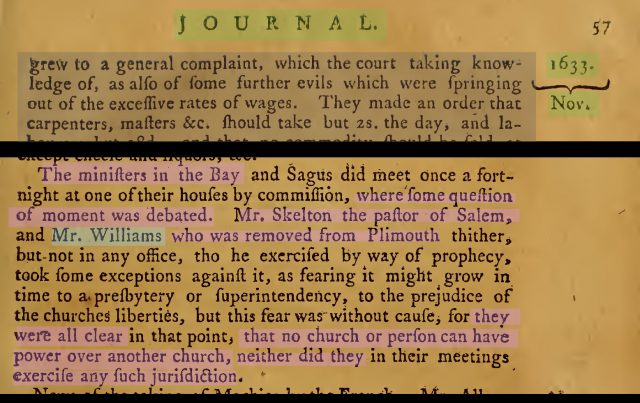
December 27, 1633: R.W. Dissents, Almost Censured
Julian to Gregorian: John’s Julian calendar of Friday 27 Dec 1633 = Friday 6 Jan 1634 Gregorian, our calendar.
Governor: John Winthrop; Deputy Governor: Thomas Dudley
Although Roger Williams is nearly censured, he manages to skirt the edge of persecution, again. He is pushing as hard as possible on his fellow citizens and on leadership to the edge of acceptable behavior. In this case, the Governor of Boston brought together some of the most conservative ministers to condemn Roger Williams. In addition to standing up for Native American rights to their own land, Williams also calls out King Charles for his religious views. Notice Williams never retracts his beliefs, but simply humbly says it was not intended for public consumption and that he didn’t mean to offend. The court accepts this pseudo-apology with no additional punishment to Williams other than having to appear and explain.
“The Governor…took into consideration a treatise which Mr. Williams (then of Salem) had sent to them…he disputes their right to the lands they professed here…they could have no title, except they compounded with the natives. …taking advice…of the most judicious ministers…condemned Mr. Williams…they…order that he should be convented at the next court, to be censured…There were three passages chiefly whereat they were much offended. 1st…that he chargeth King James to have told a solemn, public lie, because in his patent he blessed God that he was the first christian prince that had discovered this land. 2nd…he chargeth him and others with blasphemy for calling Europe Christendom or the church world. 3d. For that he did personally apply to our present King Charles those 3 places in the revelations…Mr. Endicott…wrote him to let him know…to deal with Mr. Williams to retract…Mr. Williams also wrote to the Governor…very submissively, professing his intent to have been only to have written for the private satisfaction of the gentlemen…At the next court, he appeared privately, and gave satisfaction of his intention and guild, so it was left and nothing done in it.”
Page 60 clip:
January 24, 1633/4: Council agrees to no punishment for R.W.
English Double Date: 24 Jan 1633/4 is 24 Jan 1634 (month 1); and 24 Jan 1633 (month 11).
Julian to Gregorian: John’s Julian calendar of Friday 24 Jan 1633/4 = Friday 3 Feb 1634 Gregorian, our calendar.
Governor: John Winthrop (age 46); Deputy Governor: Thomas Dudley (age 58)
Characters: Roger Williams (age 30) and wife Mary (age 25)
Although the council agreed to pass on punishment for Roger Williams, he is banished by the end of the year. So, although Williams skirted the edge, he was stubborn and resolute in his beliefs.
“The governor and council met again at Boston to consider…Mr. Williams’ letter…when…considering…offensive passages in his book…they found the matters not to be so evil as at first they seemed. …they agreed…upon his retraction…and taking an oath of allegiance to the King…it should be passed over.”
Page 61 clip:
November 27, 1634: R.W. in troubled again, summoned to court
Julian to Gregorian: John’s Julian calendar of Thursday 27 Nov 1634 = Thursday 7 Dec 1634 Gregorian, our calendar.
Governor: Thomas Dudley; Deputy Governor: Roger Ludlow
Roger Williams summoned to appear in court, again.
“It was likewise informed that Mr. Williams of Salem had broken his promise to us in teaching publicly against the King’s patent, and our great sin in claiming right…to this country…and for usual terming the churches of England Anti-Christian. We granted summons to him for his appearance at the next court.”
Page 76:
In Yellow: Endicott and the Red Cross
Also mentioned above highlighted in yellow is mention of the Endicott and the Red Cross incident. About 1634, Roger Williams gave a famous sermon which preached that the St. George Cross in the colony flag was a symbol of popery. This sermon convinced John Endicott, one of the leaders, that the St. George Cross in the colony flag was a badge of idolatry. Endicott removed the cross which was an act of vandalism. The local legislature removed him from holding any office for one year. 1635 was the only year he did not hold an office. The legislature then allowed the standard bearers of each town to adopt any flag they wish. Without exception, every town adopted the red flag with a white canton. There are many references to this flag over the next 50 years. Two hundred years later in 1837 the flag is the subject of Nathaniel Hawthorne’s story Endicott and the Red Cross, one of his Twice Told Tales.

I wonder what Roger Williams and the founding fathers would have thought when “In God We Trust” first appeared on the 1864 two-cent coin? I think it’s clear they would have objected strongly and argued against it.
What about the pledge of allegiance? Roger Williams refused all oaths and would have likely refused the original pledge of allegiance adopted in 1892, which was 116 years after the founding fathers declared independence for similar reasons. Both Roger Williams and the founding fathers would have objected to Eisenhower adding “Under God” to the pledge in 1954.
April 30, 1635: R.W. in Trouble Again
Julian to Gregorian: John’s Julian calendar of Thursday 30 Apr 1635 = Thursday 10 May 1635 Gregorian, our calendar.
Governor: Thomas Dudley (age 59); Deputy Governor: Roger Ludlow
Characters: Roger Williams (age 32) and wife Mary (age 25)
This entry is from month 2 which is April prior to 1755.
“The Governor and assistants sent for Mr. Williams; …he had taught publicly, that a magistrate ought not to tender an oath to an unregenerate man, …we thereby have communion with a wicked man in the worship of God, and cause him to take the name of God in vain. He was heard before all ministers, and very clearly confessed.”
Page 80 clip:
July 8, 1635: R.W. to be Banished at Next Court
Julian to Gregorian: John’s Julian calendar of Wednesday 8 Jul 1635 = Wednesday 18 Jul 1635 Gregorian, our calendar.
Governor: John Hanes; Deputy Governor: Richard Bellingham
There is some debate about the date of this entry. It appears after August 26 entry, but some historians indicate this occurred in July.
“…Mr. Williams…was summoned and did appear. It was laid to his charge, that…question…dangerous opinions…
1. That the magistrate ought not to punish the breach of the first table…
2. That he out not to tender an oath to an unregenerate man.
3. That a man ought not to pray with such, tho wife, children, etc.
4. That a man out not to give thanks after the sacrament nor after meat…
…notwithstanding the church had since called him to the office of a teacher. …contempt of authority…in fine there was given to him…It being…declared by the ministers…that he who should obstinately maintain such opinions…were to be removed…”
Page 84 clip:
July 12, 1635: Land Refused for Salem Church
Julian to Gregorian: John’s Julian calendar of Sunday 12 Jul 1635 = Wednesday 22 Jul 1635 Gregorian, our calendar.
Governor: John Hanes; Deputy Governor: Richard Bellingham
The Salem church wanted new land, but were refused because Roger Williams was essentially on trial for what he was preaching.
Salem men had…a petition at the lat general court for some land…but because they had chosen Mr. Williams their teacher while he stood under question of authority, …there petition was refused.
Page 85 clip:
Diary Note: The entry prior to this entry is labeled “Mo. 5. 8.”, meaning the 5th month (Mar, Apr, May, Jun, Jul), and the 8th day. The entry before that is labeled “Aug. 26”. Winthrop on occasion documented events after the fact. One can assume he entered the August 26th entry on or shortly after August 26, then the following two entries after that, but before September 1. He back-filled his journal.
August 15, 1635: R.W. Sick
Julian to Gregorian: John’s Julian calendar of Saturday 15 Aug 1635 = Saturday 25 Aug 1635 Gregorian, our calendar.
Governor: John Haynes; Deputy Governor: Richard Billingham (Titles for Massachusetts Bay Colony.)
This entry documents that Roger Williams was sick during this time so he asked his members to speak for him.
“Mr. Williams pastor of Salem being sick…would…communicate with them except they would first refuse communication with the rest…”
Page 86 clip:
November 1, 1635: R.W. Banished
Julian to Gregorian: John’s Sunday November 1, 1635 Julian = Sunday Nov 11, 1635 modern Gregorian
Governor: John Haynes; Deputy Governor: Richard Billingham (Titles for Massachusetts Bay Colony.)
Up to this point, Roger Williams managed to find a way to preach his conscience in public without persecution. On this day, he failed. He was called to task in a great meeting with all the Ministers of the bay. Mr. Hooker tried to convince Williams to renounce his views, but he wouldn’t. All he had to do was submit to the court’s will as he had done several times before, and, at most, they would make him state the same publicly. But, he refused. The big issue that led to his banishment was that he wanted his church to separate from the other churches of the bay. He wanted to be completely free to preach his views in this one church. Just like the Church of England, the bay ministers would not allow it. One could argue that this day, this stand, was the pivotal event in modern history that directly led to freedom of speech, freedom of and from religion, and freedom of conscience around the world.
Note: There was some confusion about public versus private. It’s fair to say the magistrates were most concerned with public discourse–they did not believe in free speech. After this banishment, the magistry agrees to let Williams stay until spring, but then he gets caught preaching to some in his home. Although it was his home, the magistry considered it public because he was bringing people to his home to hold service. The concept of a person’s home is their castle did not exist at this time.
“At the general court Mr. Williams the teacher of Salem was again convented, and all the Ministers in the bay being desired to be present, he was charged with…his own church to persuade them to renounce communion with all the churches in the bay, as full of antichrist, pollution, etc. He…maintained all his opinions, …Mr Hooker was appointed to dispute with him, but could not reduce him from any of his errors, so the next morning the court sentenced him to depart out of our jurisdiction within six weeks; all the ministers saye one, approving the sentence, …at his return home, refused communion with his own church, who openly disclaimed his errors, and wrote an humble submission to the magistrates, acknowledging their fault in joining with Mr. Williams in that letter to the churches against them…”
A Note About Dates
In this case, John Winthrop updated his journal on November 1st, but regarding events that took place in his 4th month, which is June 1635. If you assume John Winthrop wrote the November 1 entry on the same evening as the court was held, then that means Roger Williams was banned on November 12, 1635 (our calendar).
Early January 1636
Roger Williams escapes into the wilderness just three days before Captain Underhill arrives to arrest him. He is tipped off by a secret letter sent to him by John Winthrop.
January 1635/6: R.W. Breaks Agr, Underhill Sent to Capture him, He Escapes
English Double Date: Jan 1635/6 is Jan 1636 (month 1); and Jan 1635 (month 11).
Julian to Gregorian: John’s Julian calendar of January 1635/6 = January 1636 Gregorian, our calendar.
Governor: John Haynes; Deputy Governor: Richard Billingham (Titles for Massachusetts Bay Colony. )
By December 1635, the court agreed to allow Roger Williams to stay until spring to avoid the bitter winter. In exchange, Williams agreed to not preach on the issue he was banished for. Although he did not preach in any church, he did have guests over and he did preach to them. In fact, this is the time Roger Williams conceived Providence — place of free conscience! He was gathering followers and had plans to take them with him in the spring. He developed quite a following in Salem, especially with the women. The court found out and sent Captain Underhill to capture him, but Roger Williams escaped into the frigid winter three days prior.
“The Governor and assistants met at Boston to consider about Mr. Williams, …they were credibly informed…not withstanding the injunction laid upon him (upon the liberty granted him to stay till the spring) not to go about to draw others to his opinions, did…entertain company in his house, and to preach to them…such points as he had been censured for, and it was agreed to send him into England by ship then ready to depart. The reason was because he had drawn above twenty persons to his opinions, and they were intended to erect a plantation about the Narragansett Bay, from whence the infection would easily spread into these churches…a warrant was sent to him to come presently to Boston, to be shipped…He returned answer…that he could not come without hazard of his life…whereupon a pinnace was sent with commission to Capt. Underhill…to apprehend him, and carry him aboard the ship…but when they came at his house, they found he had been gone three days before, …He had so far prevailed at Salem, as many there (especially of devout women) did embrace his opinions and separated from the churches for this cause…”
Pages 91 and 92 clip:
Continue…
- Part 1: 1630-Jan 1636 — with quotes and clips from journal published in 1790.
- Part 2: 1636-1644 — with quotes and clips from journal published in 1790.
- Part 3: 1645-1649 — with quotes from journal published in 1908.


